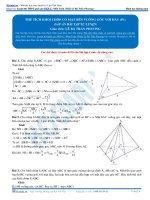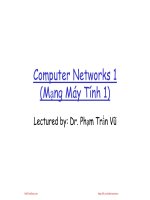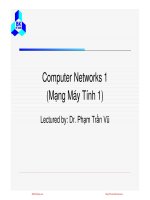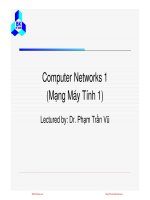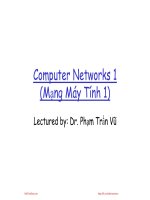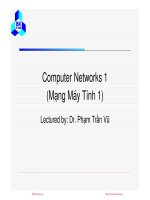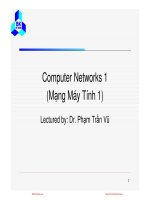mạng máy tính phạm trần vũ bài giảng 3 4 5 application layer
Bạn đang xem bản rút gọn của tài liệu. Xem và tải ngay bản đầy đủ của tài liệu tại đây (2.46 MB, 115 trang )
Computer Networks 1
(Mạng Máy Tính 1)
Lectured by: Dr. Phạm Trần Vũ
SinhVienZone.com
/>
Chapter 2
Application Layer
Computer Networking: A Top Down Approach ,
5th edition.
Jim Kurose, Keith Ross
Addison-Wesley, April 2009.
All material copyright 1996-2009
J.F Kurose and K.W. Ross, All Rights Reserved
SinhVienZone.com
Introduction
/>
1-2
Chapter 2: Application layer
2.1 Principles of
network applications
2.2 Web and HTTP
2.3 FTP
2.4 Electronic Mail
2.6 P2P applications
2.7 Socket programming
with TCP
2.8 Socket programming
with UDP
SMTP, POP3, IMAP
2.5 DNS
SinhVienZone.com
2: Application Layer
/>
3
Chapter 2: Application Layer
Our goals:
conceptual,
implementation
aspects of network
application protocols
transport-layer
service models
client-server
paradigm
peer-to-peer
paradigm
SinhVienZone.com
learn about protocols
by examining popular
application-level
protocols
HTTP
FTP
SMTP / POP3 / IMAP
DNS
programming network
applications
socket API
2: Application Layer
/>
4
Some network apps
voice over IP
web
real-time video
instant messaging
remote login
P2P file sharing
conferencing
grid computing
cloud computing
multi-user network
games
streaming stored video
clips
SinhVienZone.com
2: Application Layer
/>
5
Creating a network app
write programs that
run on (different) end
systems
communicate over network
e.g., web server software
communicates with browser
software
No need to write software
for network-core devices
application
transport
network
data link
physical
application
transport
network
data link
physical
Network-core devices do
not run user applications
applications on end systems
allows for rapid app
development, propagation
SinhVienZone.com
application
transport
network
data link
physical
2: Application Layer
/>
6
Chapter 2: Application layer
2.1 Principles of
network applications
2.2 Web and HTTP
2.3 FTP
2.4 Electronic Mail
SMTP, POP3, IMAP
2.5 DNS
SinhVienZone.com
2.6 P2P applications
2.7 Socket programming
with TCP
2.8 Socket programming
with UDP
2.9 Building a Web
server
2: Application Layer
/>
7
Application architectures
Client-server
Peer-to-peer (P2P)
Hybrid of client-server and P2P
SinhVienZone.com
2: Application Layer
/>
8
Client-server architecture
server:
always-on host
permanent IP address
server farms for
scaling
clients:
client/server
SinhVienZone.com
communicate with server
may be intermittently
connected
may have dynamic IP
addresses
do not communicate
directly with each other
2: Application Layer
/>
9
Pure P2P architecture
no always-on server
arbitrary end systems
directly communicate peer-peer
peers are intermittently
connected and change IP
addresses
Highly scalable but
difficult to manage
SinhVienZone.com
2: Application Layer
/>
10
Hybrid of client-server and P2P
Skype
voice-over-IP P2P application
centralized server: finding address of remote
party:
client-client connection: direct (not through
server)
Instant messaging
chatting between two users is P2P
centralized service: client presence
detection/location
• user registers its IP address with central
server when it comes online
• user contacts central server to find IP
addresses of buddies
SinhVienZone.com
2: Application Layer
/>
11
Processes communicating
Process: program running
within a host.
within same host, two
processes communicate
using inter-process
communication (defined
by OS).
processes in different
hosts communicate by
exchanging messages
SinhVienZone.com
Client process: process
that initiates
communication
Server process: process
that waits to be
contacted
Note: applications with
P2P architectures have
client processes &
server processes
2: Application Layer
/>
12
Sockets
process sends/receives
messages to/from its
socket
socket analogous to door
sending process shoves
message out door
sending process relies on
transport infrastructure
on other side of door which
brings message to socket
at receiving process
host or
server
host or
server
process
controlled by
app developer
process
socket
socket
TCP with
buffers,
variables
Internet
TCP with
buffers,
variables
controlled
by OS
API: (1) choice of transport protocol; (2) ability to fix
a few parameters (lots more on this later)
SinhVienZone.com
2: Application Layer
/>
13
Addressing processes
to receive messages,
process must have
identifier
host device has unique
32-bit IP address
Q: does IP address of
host suffice for
identifying the process?
SinhVienZone.com
2: Application Layer
/>
14
Addressing processes
to receive messages,
process must have
identifier
host device has unique
32-bit IP address
Q: does IP address of
host on which process
runs suffice for
identifying the
process?
A: No, many
processes can be
running on same host
SinhVienZone.com
identifier includes both
IP address and port
numbers associated with
process on host.
Example port numbers:
HTTP server: 80
Mail server: 25
to send HTTP message
to gaia.cs.umass.edu web
server:
IP address: 128.119.245.12
Port number: 80
more shortly…
2: Application Layer
/>
15
App-layer protocol defines
Types of messages
exchanged,
e.g., request, response
Message syntax:
what fields in messages &
how fields are delineated
Message semantics
meaning of information in
fields
Public-domain protocols:
defined in RFCs
allows for
interoperability
e.g., HTTP, SMTP
Proprietary protocols:
e.g., Skype
Rules for when and how
processes send &
respond to messages
SinhVienZone.com
2: Application Layer
/>
16
What transport service does an app need?
Data loss
some apps (e.g., audio) can
tolerate some loss
other apps (e.g., file
transfer, telnet) require
100% reliable data
transfer
Timing
some apps (e.g.,
Internet telephony,
interactive games)
require low delay to be
“effective”
SinhVienZone.com
Throughput
some apps (e.g.,
multimedia) require
minimum amount of
throughput to be
“effective”
other apps (“elastic apps”)
make use of whatever
throughput they get
Security
Encryption, data
integrity, …
2: Application Layer
/>
17
Transport service requirements of common apps
Data loss
Throughput
Time Sensitive
file transfer
Web documents
real-time audio/video
no loss
no loss
no loss
loss-tolerant
no
no
no
yes, 100’s msec
stored audio/video
interactive games
instant messaging
loss-tolerant
loss-tolerant
no loss
elastic
elastic
elastic
audio: 5kbps-1Mbps
video:10kbps-5Mbps
same as above
few kbps up
elastic
Application
SinhVienZone.com
yes, few secs
yes, 100’s msec
yes and no
2: Application Layer
/>
18
Internet transport protocols services
TCP service:
connection-oriented: setup
required between client and
server processes
reliable transport between
sending and receiving process
flow control: sender won’t
overwhelm receiver
congestion control: throttle
sender when network
overloaded
does not provide: timing,
minimum throughput
guarantees, security
SinhVienZone.com
UDP service:
unreliable data transfer
between sending and
receiving process
does not provide:
connection setup,
reliability, flow control,
congestion control, timing,
throughput guarantee, or
security
Q: why bother? Why is
there a UDP?
2: Application Layer
/>
19
Internet apps: application, transport protocols
Application
remote terminal access
Web
file transfer
streaming multimedia
Internet telephony
SinhVienZone.com
Application
layer protocol
Underlying
transport protocol
SMTP [RFC 2821]
Telnet [RFC 854]
HTTP [RFC 2616]
FTP [RFC 959]
HTTP (eg Youtube),
RTP [RFC 1889]
SIP, RTP, proprietary
(e.g., Skype)
TCP
TCP
TCP
TCP
TCP or UDP
typically UDP
2: Application Layer
/>
20
Chapter 2: Application layer
2.1 Principles of
network applications
app architectures
app requirements
2.2 Web and HTTP
2.4 Electronic Mail
SMTP, POP3, IMAP
2.6 P2P applications
2.7 Socket programming
with TCP
2.8 Socket programming
with UDP
2.5 DNS
SinhVienZone.com
2: Application Layer
/>
21
Web and HTTP
First some jargon
Web page consists of objects
Object can be HTML file, JPEG image, Java
applet, audio file,…
Web page consists of base HTML-file which
includes several referenced objects
Each object is addressable by a URL
Example URL:
www.someschool.edu/someDept/pic.gif
host name
SinhVienZone.com
path name
2: Application Layer
/>
22
HTTP overview
HTTP: hypertext
transfer protocol
Web’s application layer
protocol
client/server model
client: browser that
requests, receives,
“displays” Web objects
server: Web server
sends objects in
response to requests
SinhVienZone.com
PC running
Explorer
Server
running
Apache Web
server
Mac running
Navigator
2: Application Layer
/>
23
HTTP overview (continued)
Uses TCP:
client initiates TCP
connection (creates socket)
to server, port 80
server accepts TCP
connection from client
HTTP messages (applicationlayer protocol messages)
exchanged between browser
(HTTP client) and Web
server (HTTP server)
TCP connection closed
SinhVienZone.com
HTTP is “stateless”
server maintains no
information about
past client requests
aside
Protocols that maintain
“state” are complex!
past history (state) must
be maintained
if server/client crashes,
their views of “state” may
be inconsistent, must be
reconciled
2: Application Layer
/>
24
HTTP connections
Nonpersistent HTTP
At most one object is
sent over a TCP
connection.
SinhVienZone.com
Persistent HTTP
Multiple objects can
be sent over single
TCP connection
between client and
server.
2: Application Layer
/>
25


